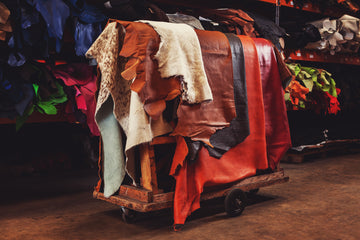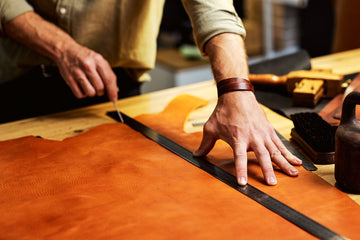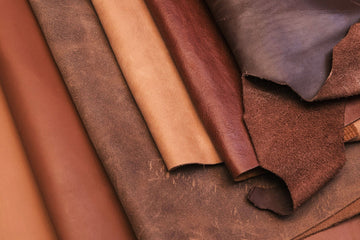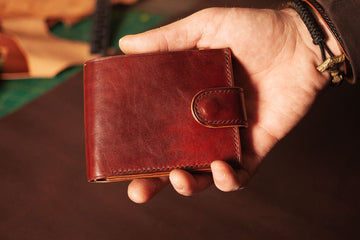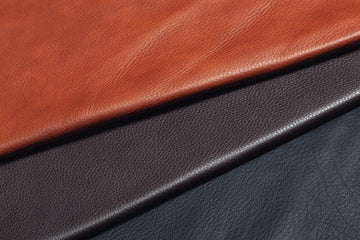Full grain leather is the premier choice for high-quality leather goods and is known for its unrivalled durability and natural beauty. Retaining the complete grain layer offers a unique, authentic look that other leathers can't match. In this article, we will explore what full grain leather is, what makes it so special, and its advantages and disadvantages.
Key Takeaways
- Full grain leather is the highest-quality leather. It is characterized by its durability, natural imperfections, and long-lasting appeal due to its unaltered state during production.
- Crafting full grain leather involves careful selection and tanning processes that maintain its natural beauty and strength, resulting in products that develop a unique patina over time.
- While full grain leather offers exceptional durability and aesthetic value, it is also more expensive and requires regular maintenance to preserve its quality and appearance.
Understanding Full Grain Leather
Full grain leather is revered as the highest-quality leather available, renowned for its exceptional durability and aesthetic appeal. Unlike other leathers, full grain leather is defined by its unique characteristics, including the natural imperfections that tell the story of the hide's life, truly representing the essence of real leather. This type of leather is thicker and more robust, contributing to its longevity and strength.
Full grain leather stands out because it remains in its natural state without sanding or alteration. This retention of full fibre strength and durability showcases unique qualities like scars and wrinkles, adding charm. The aniline finish often used enhances breathability by keeping the natural grain visible.
Full grain leather refers to the entire, unaltered hide in its natural form, preserving all unique characteristics and making each full grain leather product one-of-a-kind. This quality makes full grain leather the preferred choice for those seeking the best in leather goods.
In addition to its unmatched durability, full grain leather develops a beautiful patina over time, adding to its allure. This patina results from exposure to the environment and regular use, giving the leather a rich, unique appearance that evolves with age. The ability of full grain leather to age gracefully makes it a popular choice for high-end products meant to last a lifetime.
Moreover, full grain leather is highly resistant to wear and tear, making it ideal for crafting items that endure daily use, such as leather bags, wallets, and shoes. Its natural breathability also ensures comfort, especially in products like leather jackets and furniture that come into direct contact with the skin. This breathability helps maintain a comfortable temperature and prevents the leather from becoming overly stiff or brittle.
Full grain leather's superior quality and natural beauty make it a sustainable choice. It encourages the purchase of fewer, higher-quality items that last longer, reducing the need for frequent replacements. This sustainability aspect aligns with the growing consumer demand for environmentally responsible products, further solidifying full grain leather's status as the highest-quality leather available.
Types of Leather
Leather is a versatile material. There are various types, each with unique characteristics, advantages, and disadvantages. Understanding these differences can help you make informed decisions when purchasing leather goods.
- Full Grain Leather: Considered the highest quality leather, full grain leather is made from the hide's strongest and most durable part. It retains the complete grain layer without sanding or buffing to remove imperfections. This results in a robust and aesthetically pleasing leather, showcasing natural markings that add character.
- Top Grain Leather: The second-highest quality leather, top grain leather is made from the outer layer of the hide. Unlike full grain leather, it undergoes sanding and buffing to remove imperfections, resulting in a smoother surface. While thinner and less durable than full grain leather, top grain leather still offers a high-quality finish suitable for many products.
- Genuine Leather: Often seen as a lower-quality option, genuine leather is made from leftover scraps of leather. It lacks the durability and natural beauty of full grain or top grain full grain or top grain leather and is typically used for lower-end products. Genuine leather does not develop a patina over time, making it less desirable for those seeking long-lasting, high-quality leather goods.
- Corrected Grain Leather: This type of leather has been altered to remove imperfections. Known as corrected grain leather, it is often embossed with an artificial grain pattern to mimic the look of full grain leather. While it may appear similar to higher-quality leather, it does not offer the same durability or natural appeal.
- Split Leather: Made from the lower layers of the hide, split leather is often used for products like suede and nubuck. It is less durable than full grain, top grain, full grain, or top grain leather but can still create attractive and functional items.
How Full Grain Leather is Made
The creation of full grain leather begins with carefully selecting hides, choosing only those with minimal imperfections. This ensures the quality of the finished product, as hides with excessive flaws are rejected.
During preparation, the hide is stripped of hair, fat, and other materials to reveal natural grain patterns that remain visible throughout the leather's life.
This delicate process preserves the natural grain and split leather, crucial for maintaining the leather's strength and aesthetic appeal. It is important to note that while full grain leather is of high quality, other products labelled as genuine leather are technically leather but often made from lower-grade scraps, which may affect their durability and quality.
The tanning process transforms the hide into a stable material suitable for various leather goods. The hide is placed in a rotating drum with tanning agents like chromium or vegetable dyes until pH levels stabilise. Unlike other leathers, full grain leather undergoes tanning without sanding or chemical treatments, preserving its natural state. Methods like chrome and vegetable tanning impart different qualities to the leather, ensuring it becomes a stable material for crafting durable goods.
The final step, crusting, involves thinning, tanning again, and lubricating the hide to achieve the desired softness and flexibility. This stage often includes colouring to enhance the leather's appearance, preparing it for the final transformation into beautiful full grain leather products.
What Makes Full Grain Leather Unique
Full grain leather is distinguished by its unique characteristics, enhancing appeal and functionality. Each piece features natural markings and blemishes, telling the story of the hide's life. These imperfections are a testament to the leather's authenticity and individuality.
Derived from the outermost layer of the hide, full grain leather is more durable and robust than lower layers, including the grain layer. Its tightly interwoven fibre structure ensures it can withstand daily use, making it a preferred choice for high-quality goods.
Natural characteristics like scars and wrinkles enhance the rugged appearance of full grain leather. Its thickness requires heavy-duty tools for processing, underscoring its robustness and longevity. This blend of ruggedness and beauty makes full grain leather an exceptional material for a wide range of products, showcasing the unique leather grain.
In addition to its durability, full grain leather is renowned for its ability to develop a natural patina over time, which further enhances its visual appeal. This patina results from the leather's exposure to the environment and regular handling, creating a rich, deep colour that evolves with age. This characteristic not only adds to the aesthetic value of full grain leather but also signifies its quality and authenticity.
Moreover, the breathability of full grain leather contributes to its comfort, particularly in products that come into direct contact with the skin, such as leather jackets and upholstery. This natural breathability helps regulate temperature and moisture, preventing the leather from becoming overly stiff or brittle.
Another noteworthy characteristic of full grain leather is its versatility. It can be used in a variety of applications, from luxury handbags and wallets to durable furniture and footwear. Its natural strength and aesthetic appeal make it an ideal choice for both fashion and functional items, ensuring that full grain leather products not only look good but also stand the test of time.
Furthermore, full grain leather's resistance to moisture and wear makes it a practical choice for items that require both durability and elegance. Its ability to withstand the rigours of daily life without losing its charm makes it a valuable investment for those seeking long-lasting leather goods.
How to Identify Full-Grain Leather
Full grain leather stands out as the highest quality leather available, but distinguishing it from other types can be challenging without the right knowledge. One of the easiest ways to identify full grain leather is through its natural surface. Unlike other leather types that undergo sanding or buffing to remove imperfections, full grain leather retains all the unique markings of the hide, including scars, wrinkles, and grain patterns. These natural features add character and authenticity, making each piece truly one-of-a-kind. If the surface appears too uniform or plastic-like, it is likely not full grain leather.
Another telltale sign of full grain leather is its texture and feel. Run your fingers across the surface—authentic full grain leather will feel soft yet firm, with a slightly textured finish. Unlike synthetic or corrected leather, it lacks artificial coatings that give a smooth, glossy appearance. Pressing on full grain leather may show slight creasing or a "pull-up" effect, where the natural oils shift and create a lighter shade, demonstrating its quality and authenticity.
Is full grain leather real leather? The answer is an emphatic yes. Full grain leather is not only real but also the most authentic and unaltered form of leather. It is made from the hide's top layer, where the natural grain is fully intact. This layer is the hide's strongest and most durable part, ensuring longevity and resilience. Unlike lower-quality leathers, such as bonded or genuine leather, full grain leather celebrates its natural state rather than disguising it.
Tanning methods are another crucial indicator of quality. Full grain leather is commonly processed using vegetable tanning, which uses natural tannins derived from tree bark and leaves. This process enhances the leather's natural characteristics and ensures it develops a rich patina. Alternatively, some full grain leather is chrome-tanned, which can yield a softer, more flexible product while maintaining strength.
Craftsmanship is the final factor that distinguishes premium full grain leather. The best full grain leather products are crafted with precision and care, using techniques that preserve the integrity of the material. High-quality stitching, edge finishing, and attention to detail ensure the leather remains durable and visually appealing for years.
Characteristics of Full Grain Leather
High-quality leather is distinguished by several key characteristics that set it apart from lower-quality options. Recognising these traits can help you identify superior leather products.
- Natural Grain: One of the most telling signs of high-quality leather is its natural grain pattern. Each hide has a unique texture, with visible markings and imperfections that add to its authenticity and charm.
- Thickness: High-quality leather is typically thicker and more robust, contributing to its durability and longevity. This thickness ensures the leather can withstand daily wear and tear, making it a reliable choice for various products.
- Softness: Despite its thickness, high-quality leather often feels soft and supple. This combination of softness and strength makes it comfortable while maintaining its structural integrity.
- Breathability: Quality leather allows airflow and moisture transfer, enhancing comfort, especially in shoes and clothing. This breathability helps prevent overheating and keeps the leather in good condition.
- Patina: Over time, high-quality leather develops a beautiful patina, a sheen that forms on the surface due to use and exposure. This patina adds depth and richness to the leather, making it more attractive as it ages.
Full Grain Leather vs. Other Leather Types
Comparing full grain leather to other types reveals striking differences. Top grain leather, called corrected grain leather, is created by sanding the outer layer of the hide. It is less durable and loses many of the natural markings that give full grain leather its character. While it may have a smoother surface, it lacks the authenticity and strength of full grain leather.
Genuine leather, often seen as a lower-quality option, is made from scraps and lacks the durability of full grain leather. It also does not develop the beautiful patina over time that full grain leather does, which enhances its appeal and uniqueness as it ages. Consequently, full grain leather products tend to be more expensive due to their superior quality and longevity.
Overall, full grain leather is tougher and heavier than many other types, contributing to its reputation as a high-quality material. Made from the entire hide, it retains natural imperfections and unique markings, setting it apart from other grades that undergo more extensive processing and alteration.
Modern fashion's shift towards full grain leather represents a commitment to higher-quality leather materials over mass-produced alternatives. This preference for full grain leather is not just about aesthetics; it's also about sustainability and ethical sourcing.
As consumers become more conscious of the environmental impact of their purchases, full grain leather offers a more sustainable option. Its durability means that products last longer, reducing the need for frequent replacements and minimising waste.
Furthermore, the natural ageing process of full grain leather, which develops a unique patina, adds a personal touch to each item, making it more than just a product but a piece that tells a story. This aspect is particularly appealing in an era where personalised and unique items are highly valued. Full grainFull grain leather's ability to age gracefully and adapt to the user's lifestyle enhances its desirability.
Full grain leather's robust nature makes it a preferred choice for crafting heavy-duty items like saddles, harnesses, and protective gear, where strength and durability are paramount. Its natural breathability also makes it ideal for items like shoes and jackets, where comfort is as important as durability.
The preference for full grain leather over other types is driven by its unmatched quality, sustainability, and the unique character it develops over time. This makes it a superior choice for those seeking long-lasting and distinctive leather goods.
Common Products Made from Full Grain Leather
Full grain leather is used to craft various products, benefiting from its durability and aesthetic appeal. Common items include furniture, dress shoes, work boots, belts, duffel bags, and wallets, all exuding a sense of luxury and sophistication.
Notable items made from full grain leather include weekender bags and wallets. These items are designed to withstand daily use while maintaining their classic appearance. The durability of full grain leather ensures these items can endure the test of time, often looking better with age.
The longevity and appealing aesthetics of full grain leather products make them worthwhile investments. Whether a sturdy pair of work boots or an elegant leather bag, these products offer unmatched quality and style.
In addition, full grain leather is widely used in crafting high-end luggage, laptop sleeves, and even phone cases, offering protection and a touch of elegance. The material's natural resilience makes it a popular choice for motorcycle gear, including jackets and gloves, where safety and durability are paramount.
Moreover, full grain leather is favoured for crafting bespoke furniture pieces, adding a timeless charm to interiors. Its natural patina and unique markings enhance the aesthetic value of sofas, armchairs, and ottomans, making them stand out in any room. This versatility ensures that full grain leather remains a staple in both fashion and interior design, catering to those who appreciate quality and longevity in their purchases.
Advantages of Full Grain Leather
A primary advantage of full grain leather is its exceptional durability. Due to its natural thickness and resistance to wear, full grain leather products can last for decades, making them a smart investment for those seeking long-lasting quality. This durability stems from the leather's unaltered state, preserving its full fibre strength.
Another significant benefit is the development of a desirable patina over time, enhancing the leather's appearance and adding character and depth. The ageing process makes full grain leather even more beautiful, making it a timeless symbol of luxury and craftsmanship.
Furthermore, full grain leather's breathability adds to its comfort, especially in products like jackets and shoes that are worn close to the skin. This breathability helps regulate temperature and moisture, preventing the leather from becoming stiff or uncomfortable. The natural grain also provides a unique texture and appearance, setting full grain leather apart from other leather types.
Additionally, full grain leather's ability to develop a rich patina enhances its visual appeal and signifies its high quality. This patina is a testament to the leather's authenticity and the story it tells over time, making each piece truly one-of-a-kind.
Moreover, full grain leather's superior quality makes it a sustainable choice, encouraging the purchase of fewer, higher-quality items that last longer and reduce waste. This aligns with the growing consumer demand for environmentally responsible products, further enhancing full grain leather's appeal.
Full grain leather's resistance to moisture and wear makes it a practical choice for crafting items that require both durability and elegance. Its ability to withstand daily use without losing its charm makes it a valuable investment for those seeking long-lasting leather goods.
Benefits of Investing in Full Grain Leather
Investing in full grain leather products offers numerous benefits that make them a worthwhile choice for those seeking quality and longevity.
- Durability: Full grain leather is incredibly durable and can last many years with proper care. Its natural thickness and resistance to wear make it an excellent investment for items that see frequent use.
- Quality: Full grain leather is the highest-quality leather available. It offers a rich and luxurious look and feel. Its unaltered state preserves the hide's natural beauty, making each piece unique.
- Unique Character: Each full grain leather product has its own unique character, with natural imperfections that tell the story of the hide's life. This individuality makes full grain leather items one-of-a-kind.
- Investment Piece: Full grain leather products are often considered investment pieces. Their durability and timeless appeal mean they can last for many years and even increase in value over time.
- Sustainability: Full grain leather is a sustainable material made from natural hides that can be repaired and maintained easily. Choosing full grain leather supports sustainable practices and reduces waste.
Disadvantages of Full Grain Leather
Despite its many advantages, full grain leather has a few drawbacks. One primary disadvantage is its cost, as it is generally more expensive than other types of leather. This higher price reflects the quality and durability of the material, often classifying full grain leather products as luxury items.
Working with full grain leather presents challenges due to the prohibition of chemical processes, making the leather tougher to manipulate. This difficulty can result in higher production costs and longer manufacturing times, contributing to the overall expense of full grain leather goods.
Additionally, full grain leather is less resistant to stains than some other materials. Natural defects like scars and blemishes make it less consistent in appearance and texture. While these imperfections add character, they may be undesirable for those seeking a more uniform look.
Another consideration is that full grain leather requires more maintenance to preserve its natural beauty and strength. Regular cleaning and conditioning are necessary to prevent the leather from drying out or becoming damaged over time. This maintenance can be time-consuming and may deter some consumers who prefer low-maintenance materials.
Furthermore, the thickness and rigidity of full grain leather can make it less flexible and heavier than other leather types, potentially limiting its use in certain applications where lighter or more pliable materials are preferred. This can affect the comfort and practicality of items like clothing or accessories that require a softer touch.
Lastly, while often seen as a benefit, full grain leather's natural ageing process may not appeal to everyone. Some individuals prefer a consistent appearance that does not change over time, which is not the case with full grain leather as it develops a patina. This evolving look might not suit all tastes, especially those favouring a more polished and uniform aesthetic.
Common Misconceptions About Full Grain Leather
There are several common misconceptions about full grain leather that can deter potential buyers. Let's address and debunk these myths.
- Full grain Leather is Too Expensive: While full grain leather can be more expensive than lower-quality leather, it is often worth the investment due to its durability and quality. Over time, the cost is offset by the longevity and timeless appeal of full grain leather products.
- Full grain Leather is Too Stiff: Full grain leather can be stiff initially, but it will soften and become more supple with use and proper care. This initial stiffness indicates its quality and durability, ensuring it will last for years.
- Full grain Leather is Too High Maintenance: Contrary to popular belief, full grain leather is relatively low maintenance. It can be easily cleaned and conditioned with natural products; regular care will keep it looking its best.
- Full grain leather is Not Suitable for Everyday Use: Although it is incredibly durable and can withstand everyday use, its robust nature makes it an excellent choice for items like bags, shoes, and other accessories that see frequent wear.
By understanding and addressing these misconceptions, you can appreciate full grain leather's true value and practicality, making it a smart choice for your leather goods.
Caring for Full Grain Leather
Maintaining full grain leather is more demanding than maintaining other types. It requires regular cleaning and conditioning to preserve its quality. Routine maintenance keeps full grain leather items looking their best and extends their lifespan.
Clean full grain leather with a soft, damp cloth and use warm water for tougher stains. Avoid hard brushes or harsh chemicals, which can damage the leather. Apply a quality leather conditioner every 3 to 6 months to keep it supple and maintain its quality after cleaning.
When applying conditioner, use a small amount on a lint-free cloth and apply in a gentle, circular motion. To prevent damage and degradation, avoid exposing full grain leather to harsh chemicals. Store leather items in breathable fabric bags instead of plastic to avoid trapping moisture and causing mould.
For tougher stains, use a specialised cleaner suitable for full grain leather. Store full grain leather products in a cool, dry area to protect them from mould and maintain their shape. Allow wet leather to air dry at room temperature, avoiding direct heat.
Handle full grain leather bags gently to avoid undue stress on seams and material. Conduct a patch test on an inconspicuous area before applying any new cleaner or conditioner to prevent undesired changes. Minor scuffs on oiled full grain leather can be removed by rubbing with a moistened finger.
Full Grain Leather in Fashion and Design
Designers value full grain leather for its ability to be both rugged and refined, adapting well to various styles. The material is increasingly favored in modern fashion for its authenticity and unique character that develops over time. Full grain leather is not just about durability; it's about making a statement. Whether in a high-end handbag or bespoke furniture, full grain leather exudes quality and sophistication.
Full grain leather is widely used for making durable and stylish furniture, adding elegance to any space. Products made from full grain leather often showcase a rich patina that enhances beauty and tells a story of wear and experience. This patina is highly prized in fashion, making each piece unique and more desirable.
Why Full Grain Leather is the Gold Standard for Quality and Durability
Full grain leather stands out as the highest-quality leather available. It is known for its durability, unique characteristics, and timeless appeal. Its natural imperfections and the development of a rich patina over time make it a sought-after material in fashion and design. Whether used in furniture, shoes, or accessories, full grain leather products are a testament to superior craftsmanship and quality.
Full grain leather is the gold standard for those looking to invest in durable, stylish, and high-quality leather goods. Its ability to age gracefully and maintain its strength makes it a valuable addition to any collection. Embrace the beauty and resilience of full grain leather and enjoy the luxury it brings to your life.
Where to Buy Full Grain Leather?
Rolford Leather is the UK’s leading destination for premium full grain leather hides. Renowned for our commitment to quality, we provide a wide selection of top-tier full grain leather perfect for crafting luxurious, durable products. Whether you’re an artisan, designer, or hobbyist, our full grain leather hides are carefully sourced and processed to maintain their natural beauty and durability, making them ideal for high-end creations.
🔗 Explore our full grain leather collection
How to Buy Full Grain Leather Online?
Looking for full grain leather hides for your next project, whether it’s reupholstering furniture, crafting accessories, or producing bespoke designs? Rolford Leather offers premium full grain leather in various colours, textures, and finishes to suit every need. With an emphasis on quality and authenticity, we ensure that each hide meets the highest standards, offering you the best value for your investment.
🔗 Shop full grain leather online
If you have questions about full grain leather or need guidance on selecting the right leather for your project, our team is here to help. Contact us to learn more about the unique properties of full grain leather, ensuring you make an informed choice that enhances the quality, durability, and beauty of your creations.
